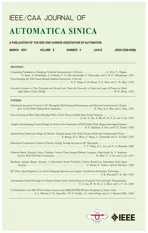Co-Simulation of an SRG Wind Turbine Control and GPRS/EGPRS Wireless Standards in Smart Grids
2021-04-16AndreLuizdeOliveiraCarlosEduardoCapovillaSeniorMemberIEEEIvanRobertoSantanaCasellaSeniorMemberIEEEJosLuisAzcuePumaandAlfeuSguareziFilhoSeniorMemberIEEE
Andre Luiz de Oliveira, Carlos Eduardo Capovilla, Senior Member, IEEE, Ivan Roberto Santana Casella, Senior Member, IEEE, José Luis Azcue-Puma, and Alfeu J. Sguarezi Filho, Senior Member, IEEE
Abstract—Wind energy can be considered a push-driver factor in the integration of renewable energy sources within the concept of smart grids. For its full deployment, it requires a modern telecommunication infrastructure for transmitting control signals around the distributed generation, in which, the wireless communication standards stand out for employing modern digital modulation and coding schemes for error correction, in order to guarantee the power plant operability. In some developing countries, such as Brazil, the high penetration of commercial mobile wireless standards GPRS and EGPRS (based on GSM technology) have captivated the interests of the energy sector, and they now seek to perform remote monitoring and control operations. In this context, this article presents a comparative performance analysis of a wireless control system for a wind SRG, when a GPRS or EGPRS data service is employed. The system performance is analyzed by co-simulations, including the wind generator dynamics and the wireless channel effects. The satisfactory results endorse the viability and robustness of the proposed system.
I. INTRODUCTION
POWER grids, in accordance with the smart grid (SG)concept, have recently received substantial investments to optimize the use of renewable energy sources (e.g., wind and solar) [1]-[4]. SG is a modern concept of infrastructure and management of electricity (consumption, distribution,transmission, and generation) [5], [6], where the use of modern communication technologies for monitoring and control allows increasing performance of the power grid [7], [8].
Focusing in modern wind systems, communication and data sharing capabilities of generators are essential to optimize power generation and increase equipments lifetime [9]. Thus,to ensure the adequate monitoring and control of all system parameters of interest for an efficient operation, a reliable communication network is necessary [10].
With the constant evolution of wireless systems, the use of wireless standards in the area of wind energy is of particular interest from a technical and economic point of views.However, the replacement of a traditional wired control system to a wireless control system brings new challenges which require further investigations to verify its effectiveness.For instance, both, urban and rural areas of Brazil, still have massive use of low cost data networks based on second generation (2G) global mobile communication system (GSM)standard, such as general packet radio service (GPRS) and enhanced GPRS (EGPRS), despite the availability of 3G and 4G mobile wireless technologies.
This has motivated energy companies to carry out the necessary monitoring and control tasks in the SG [11], [12]through these 2G technologies. Complementarily, GPRS and EGPRS have currently been the main focus of machine-tomachine systems [13], and it is important to highlight that there are several academic works referencing the use of mobile standards in a multilayer scheme for end-to-end connectivity in industrial applications [12], [14] or to monitor wind power systems based on sensor networks [15]-[17]. In addition, GPRS and EGPRS have been widely used to offer low and medium data rate services, respectively [18].
These services can be easily contracted through one of several GSM or 4G operators (since 4G standards maintain compatibility with GSM standards). They offer several advantages which are inherent to any wireless system, such as installation simplicity (does not require installation of cable systems connecting the control center and wind generators),flexibility (ease of expanding or changing the coverage area),along with the exclusive advantages of commercial standards,such as low cost of deployment (uses of existing infrastructure) and maintenance (especially when compared to optical fibers). They also provide high reliability, good information security, great flexibility for use as primary or secondary communication system, and a wide coverage area(national or global coverage) when compared to some proprietary wired (e.g., optical or coaxial cables) or wireless(e.g., Zigbee, Bluetooth, wireless fidelity (WiFi)) solutions[8], [19].
However, the use of these services (GPRS and EGPRS) for the energy control of wind plants can be dangerous due to the arising of impulsive distortions in the form of spikes in the control signal received at the wind generator, caused by the degrading effects of the radio propagation channel (errors during signal transmission) [20]. These spikes can result in serious problems for the wind generator and to the power grid,making it imperative to use a robust and reliable communication scheme to guarantee their correct operation and extend their lifetime [9], [20].
Looking to the generator side, the most common used ones in wind systems are the Synchronous Generators, Squirrel-Cage Induction Generator, and Doubly-Fed Induction Generator [21]-[23]. However, the switched reluctance generator (SRG), which has satisfactory performance for micro-grids and isolated systems with relatively low loads, is an alternative and interesting generator for wind systems[24]-[26]. The SRG can operate at fixed or variable speed regime, and has features including mechanical robustness,high starting torque, high efficiency, and low cost [27], [28].Its performance operating in variable speed mode can be verified in [29].
In this context, this work proposes a performance analysis of a wind SRG connected to the grid, where the power references are sent through GPRS and EGPRS schemes, for realistic standard scenarios, according to the diagram presented in Fig.1. The performance of the commercial GPRS and EGPRS services is analyzed in detail in order to determine which is most suitable for the proposed application [20].

Fig.1. Wireless power control system.
Thus, differently from previous works [20], [30]-[32], the novelty of the proposed work resides on the use of a reliable mobile communication standard (recognized and used worldwide) to remotely transmit power references to a controller located in a strongly non-linear system such as the wind SRG, mitigating transmission errors, and also, in the feasibility analysis of the wireless solution and its impact on the system as a whole.
Due to the SRG nonlinearities, it is very difficult to predict the effective improvement in performance and robustness of the control system against the wireless channel impairments.In this way, this work brings some important results regarding the feasibility and performance of the proposed system using a complete co-simulation model which integrates the stages of telecommunications, control, and wind generator.
This work is organized into four sections, besides the introduction. Section II presents the adopted model of the wind power generation system and Section III outlines the standard GPRS and EGPRS wireless communication systems.In Section IV, the analyses of the main results are presented and discussed. Finally, Section V concludes the work.
II. SRG MODEL
The SRG has a simple structure. The rotor is fabricated using ferromagnetic material with salience poles without coils and its stator has field coils in the slots. These features provide advantages such as easy maintenance/repair due to concentrate on the stator windings, and low-cost manufacturing and materials [33].
The windings of SRG are excited as a function of the rotor angular position and based on the flux variation. Thus, rotor magnetic circuit reluctance is changed and the terminal voltage of each phase ( v) is given by

where i is the terminal current, L the stator inductance, ω is the rotor speed, and θ is the rotor position.
Besides, the electromotive force E is given by

It is important to note that the polarity of E must be negative, so that the machine operates as generator and converts mechanical power into electrical, since the signals of i and ω are positive [34], [35].
Finally, looking to the mechanical dynamics, its motor and load inertia ( J) is given by

where Tmis the mechanical torque, which has the same value of electromagnetic torque ( Te), given by

A. SRG DC Link Voltage Control System
There are several types of control for SRGs based on asymmetric half bridge (AHB) converters [36], [37]. The adopted AHB converter topology is presented in Fig.2.
The AHB converter operates as follows: when two switches(each phase) of the SRG open, the excitation operation occurs.Thus, the current flows from the DC link to the coil. When two switches of the SRG are turned off, the generation operation occurs. Thus, the current flows through the diodes to the DC link.
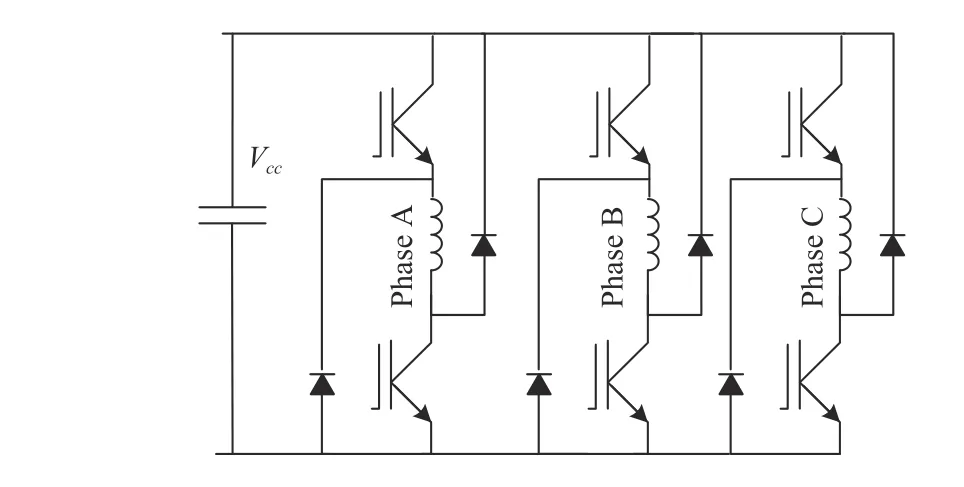
Fig.2. AHB converter topology.
The DC link voltage control of the SRG is presented in Fig.3 at the SRG side converter, with the limiter box limiting the high current in the SRG. As an example, a direct power control application (similar of used here) for SRG is presented in [31]. In that work, the AHB controls the DC link voltage,and the AHB converter is driven as follows: the turn on angle θonis constant and the θoffis calculated by a proportionalintegral (PI) controller, which process the error between the reference of CC link voltage (Vcc-ref) and its observed value( Vcc) . So, this angle θoffis given by

where Kpis the proportional gain and Kiis the integral gain of the PI.
B. Grid Converter Control
In this work, a voltage source converter is used for the active (P) and reactive (Q) power control injected to the grid.In fact, SRG produces a lot of power ripples, so that, the control of constant voltage or power is a huge challenge [31],[36]. To overcome this disadvantage, the powers are controlled via grid voltage oriented control.
In this application, the grid voltage angle θgis computed by a classical synchronous reference frame phase locked loop(PLL) [38], [39] for simplicity, with the electrical grid operating in an ideal condition (fixed frequency and amplitudes). Thus, grid voltage vector components become vg=vdgand vqg=0, and the P and Q can be given by

Equations (6) and (7) demonstrate the power can be controlled through current regulation since the grid is in normal operation. So, the current references can be calculated as
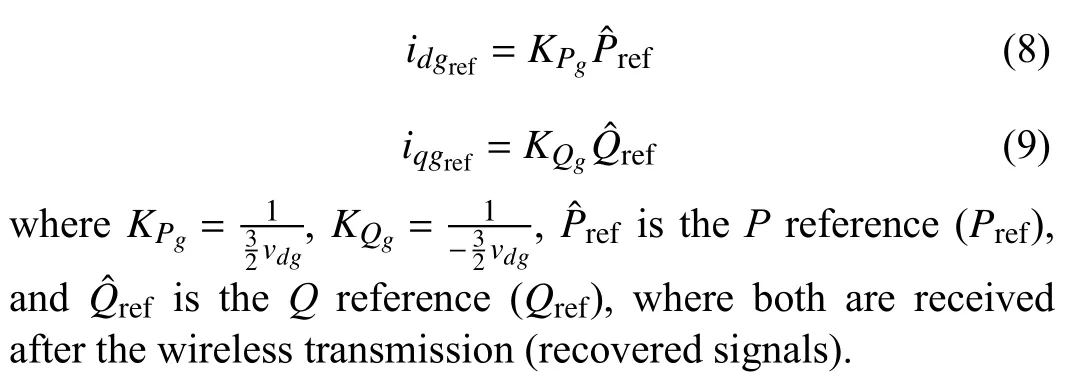
The current control is achieved with two PI controllers which process the errors between the references and its observed values. The PI controllers calculate each component of the voltage of the inverter ( vf) connected to the grid, been given by

where Kpsand Kisare the gains of the PI controllers.
Finally, the inverter voltage vector transformed to the abc coordinate system is applied to the sinusoidal pulse width modulation (SPWM) algorithm. The converter control is shown in close (box of the grid side converter control) in Fig.3.
III. WIRELESS COMMUNICATION
A. GPRS Standard
The GSM has been the most widespread worldwide 2G standard. Despite the high penetration of the 3G and 4G standards, it has been still usually employed to offer voice services in places that are remote and have low data rate services (e.g., wireless credit card machines) with low cost and wide coverage.
GPRS is part of the GSM standard and is one of the most successful low data rate services [18]. It is a continuously connected service based on packet switching and is therefore priced according to the amount of data transmitted. It can operate in multi-slot mode and uses Gausssian minimum shift keying (GMSK) modulation with bandwidth-time of 0.3. In addition, in the configuration set 1 (CS1) mode, it uses convolutional coding (CONV) with a coding rate of 1/2,constraint length of 5 and generator polynomials given by (31,33) [18].
It commonly operates on 850 MHz, 900 MHz, 1.8 GHz, and 1.9 GHz, depending on region and mobile service operator,and can reach the average rate of approximately 20.0 kbps per time slot (i.e., employing 4 time slots, the data rate can reach about 80.0 kbps) [40].
Among the GPRS operation modes, CS1 offers the best error correction capability, so it is the most suitable candidate for the proposed wireless control system. In the transmission process, Prefand Qrefpass through the analog to digital conversion (ADC), multiplexing, 1/2-CONV, interleaving and, finally, GMSK modulation stage.
B. EGPRS Standard
EGPRS can be considered an advance of GPRS as it offers higher data rates. Like GPRS, it is also a packet switching service, continuously connected, priced according to the amount of data transmitted and which also operates in multislot mode. However, it can employ GMSK or 8PSK modulations depending on the selected mode of operation and uses a different CONV with an encoding rate of 1/3,constraint length 7, and generator polynomials given by (155,117, 123) [18].
In addition, EGPRS can operate in the same frequency ranges as GPRS and can achieve average bit rates of around 59.2 kbps per time slot (i.e., for a user using 4 time slots, the data rate can reach approximately 236.2 kbps) [40].

Fig.3. SRG connected to the grid control.
Among the EGPRS operation modes, the modulation code scheme 5 (MCS5), which uses 8PSK modulation, offers the best error correction capability of the 1/3-CONV of the EGPRS and, therefore, is the most suitable candidate mode for the proposed wireless control system. In the transmission process, the Prefand Qrefpass through the ADC, multiplexing,1/3-CONV, interleaving and, finally, the 8PSK modulation stage.
C. Radiopropagation Channel
In this work, it is assumed that the wireless channel presents a frequency-flat Rayleigh fading with Doppler spread( fD=180 Hz), besides the effect of the additive white Gaussian noise (AWGN).
The mathematical model of the fading is a sequence of zeromean complex Gaussian random variables with autocorrelation function given by [41]

where J0() is the zero-th order Bessel function.
In this way, the complex low-pass signal at the receiver input (in the wind generator) can be represented by

where r is the signal vector (received), γ is the Rayleigh channel coefficient (Rayleigh magnitude and uniform phase distributions), s is the transmitted signal vector (after CONV,interleaving, and digital modulation processes), and n is the AWGN vector.
After the signal reception, the tasks of channel estimation,coherent demodulation, block deinterleaving, and Viterbi decoding [42] are conducted at the receiver. The resulting digital signals, after the digital to analog conversion (DAC),are a reconstruction of the power references, wireless transmitted by the system operator and used by the wind SRG control. Particularly, in the GMSK demodulation process, it uses 4 symbols and a retrace length of 16 symbols.
IV. PERFORMANCE ANALYSIS AND DISCUSSION
The performance of the wireless control system is analyzed in a Matlab/Simulink simulation model (co-simulation of the telecommunications and power systems), considering the parameters of the wind SRG listed in Table I.
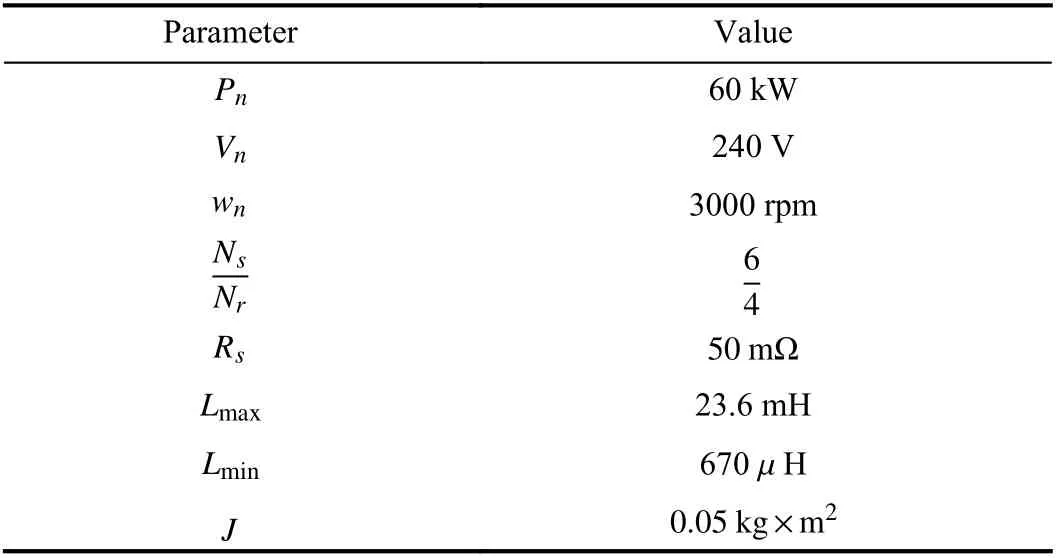
TABLE I MAIN PARAMETERS OF THE WIND SRG
For the tests, the SRG rotor speeds are 125.6 rad/s with the Prefand power factor references ( PFref) according to the following patterns: Prefstarts in -1.5 kW and changes to -1 kW at 1 s, then Prefchanges to -500 W at 1.25 s; PFrefstarts in-0.9 and changes to 0.9 at 1.0 s, then PFrefchanges to 1.0 at 1.25 s (both Prefand PFrefare periodic patterns). With these patterns, the Qref(to be effectively wireless transmitted) can be calculated as

To determine the behavior of the proposed systems in flat fading channels, a bit error rate (BER) analysis was performed varying the signal-to-noise ratio ( Eb/N0). The obtained results, presented in Fig.4, show that the performance of EGPRS is better than the performance of GPRS. For example,for a BER of 10-4, EGPRS-MCS5 requires an Eb/N0of approximately 16 dB, while GPRS-CS1 requires an Eb/N0of 19.5 dB. However, it is important to note that, even for an Eb/N0which is relatively high, errors may occur, showing the necessity of a well-dimensioned system. For the performed analysis, it adopts an Eb/N0of 16 dB for a satisfactory operational approach (BER lower than 10-3for both systems).

Fig.4. Performance of GPRSC-CS1 and EGPRS-MCS5 in a flat fading channel.
A. Wireless Control Based on GPRS-CS1
Initially, a zoom of the DC link voltage response for the SRG control using GPRS-CS1 is presented in Fig.5. It can be seen that the controller has a satisfactory performance even in the presence of some spikes in the signal caused by errors in the wireless communication.

Fig.5. GPRS-CS1-DC link voltage response.
The response of the P and Q delivered to the grid is presented in Fig.6, including a zoomed-in view. It can be observed that the references are followed, however, in some time instants there are spikes due to the errors caused by the communication channel. These errors may jeopardize the operation of the wind power system through the degradation of the converter or causing the insulated gate Bipolar transistors (IGBTs) to be driven in inappropriate time instants,which can result in a critical situation (e.g., if there are errors in the energy reference information, the IGBT switches of the wind generator can be serious damaged and compromise the power supply of an industrial plant or an entire region).
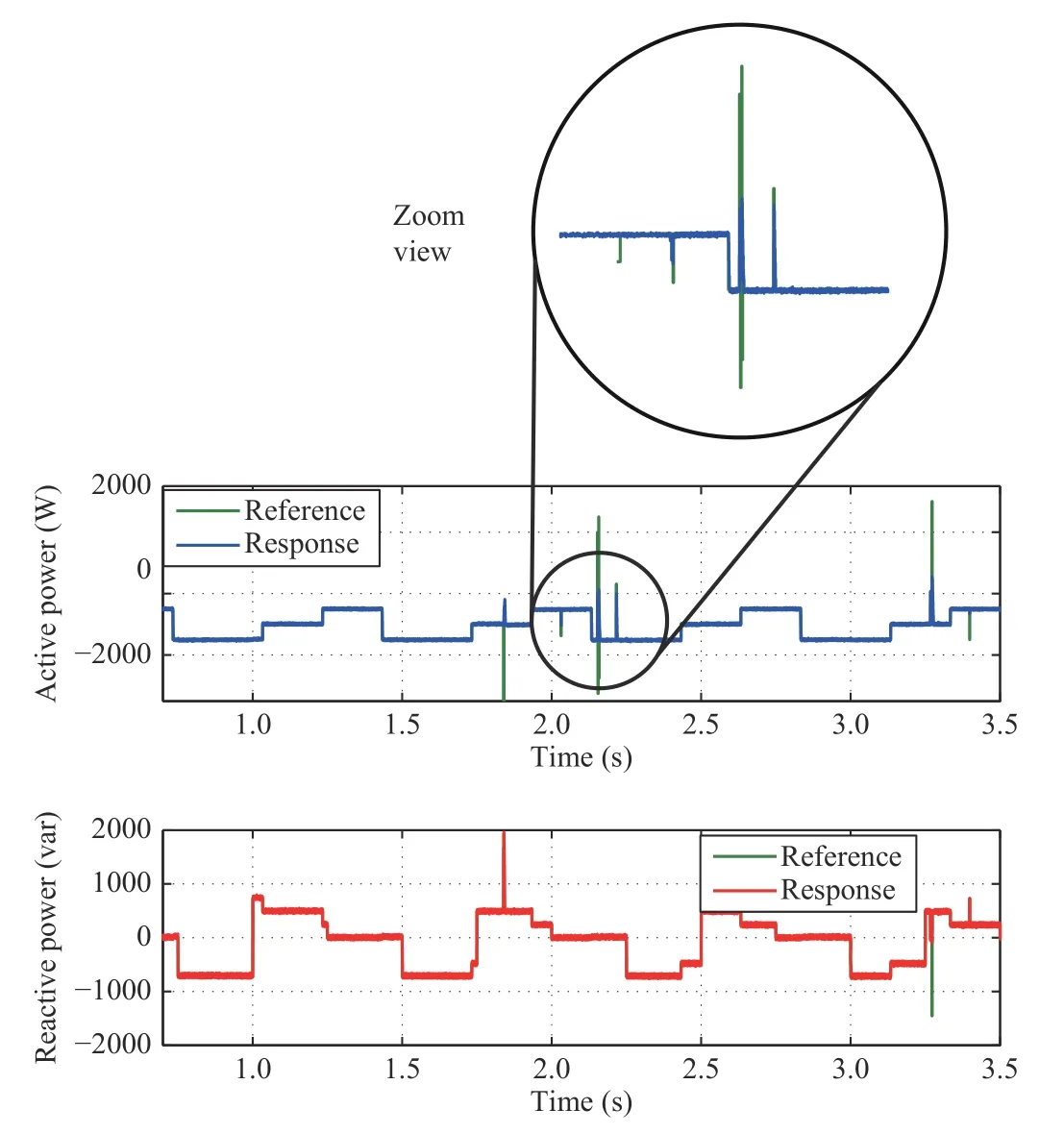
Fig.6. GPRS-CS1-Control system response.
The grid voltage and current of phase a are presented in Fig.7,where a distortion in the current signal, due to errors caused by the communication channel, can be easily verified. The total harmonic distortion (THD) of the grid side current,shown in Fig.8, has a high value of 16.98%. As can be noted,this value is not satisfactory and compatible, for several grid codes [43].

Fig.7. GPRS-CS1-Grid side current and voltage.
B. Wireless Control Based on EGPRS-MCS5
With the same procedure used to verify the GPRS-CS1 performance, a zoom of the DC link voltage response for the SRG control using EGPRS-MCS5 is presented in Fig.9. It can be seen that the references are perfectly followed and there are only a few spikes. In this case, the operation of the wind energy system is not compromised.
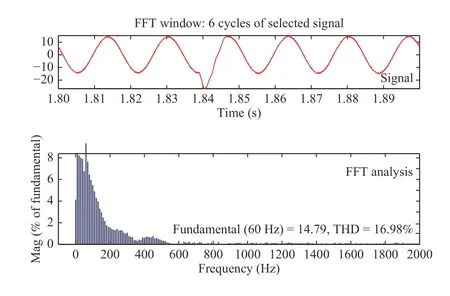
Fig.8. GPRS-CS1-THD of the grid side current.

Fig.9. EGPRS-MCS5-DC link voltage response for EGPRS-MCS5.
The response of the P and Q delivered to the grid is presented in Fig.10, including a zoomed-in view. Again, the controller presents a satisfactory performance, however, in this case, practically, there are no spikes caused by the wireless communication, showing a better operational performance than GPRS-CS1.
The grid voltage and current of phase a are presented in Fig.11. A soft distortion in the current signal is observed in some few time instants and not implicates in operability problems. The THD of the grid side current, shown in Fig.12,presents the improvements in the use of EGPRS instead of GPRS in the overall quality of the communication link to control the wind generator, resulting in a reduction in the THD of the grid side current from 16.98% to 2.24%, making this implementation an operational one. With this approach,the value of THD is adequate for several grid codes [43].
C. Discussion of Results
The results presented in Fig.4 show that EGPRS has a better error performance (expressed in terms of BER) than GPRS. The better error correction capability of EGPRS can significantly reduce the effect of impulsive distortions (spikes)on the performance of the communication system for practical values of Eb/N0compared to GPRS. The errors which appear in the form of spikes are caused by noise and fading on the power reference signals transmitted from the control center to the receiver, located in the wind generator, due to the degrading effects of the radio propagation channel.

Fig.10. EGPRS-MCS5-Control system response.
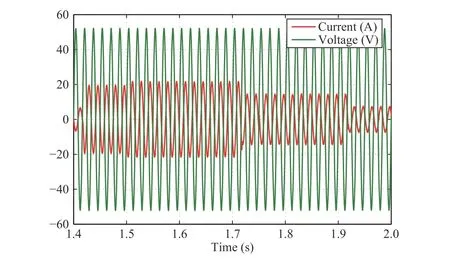
Fig.11. EGPRS-MCS5-Grid side current and voltage.
Transmission errors, caused by the wireless channel, appear as spikes in the power reference signals reconstructed at the receiver due to the digital data received over time being quantized in the receiver’s DAC and can generate random variations in the magnitude of the recovered power reference signals (which can be quite different from the correct values).This unwanted variation of the control signal can cause serious problems to the wind system. Thus, the use of EGPRS proves to be quite advantageous in relation to GPRS as it can increase the robustness of the control system and the life of the wind generator (for example, it can reduce the probability of errors occurring in the power references which can damage the IGBT switches of the wind generator controller).
As a consequence, under the same transmission conditions,the use of GPRS results in much more transmission errors than the use of EGPRS and a much higher grid side current THD. For example, for an Eb/N0of 16 dB, the grid side current THD using the system based on GPRS is 16.98%,while for the system based on EGPRS it would be 2.24%. In fact, in this case, the grid side current THD, considering the system based on GPRS, would not be in accordance with the operational limit established by most grid codes.
In this way, a good analysis of the variables of the wireless system is always necessary to ensure that the power delivered to the grid will meet the required reliability and quality for operational wind energy systems.
V. CONCLUSION
This paper is about a multidisciplinary and complex operational wireless control system (telecommunication jointly with power system). It has proposed and investigated the performance and feasibility of a control that employs GPRS/EGPRS for transmission information from the central operator unit to a wind SRG, which is a strongly nonlinear system. The adopted GPRS/EGPRS modes provide interesting solutions due to their flexibility and high information reliability and security. Also, they offer a significant reduction in deployment and operating costs in a modern wind energy system.
The evaluated EGPRS operating mode has shown the best performance in terms of robustness to the transmission errors and bit rate. In spite of the differences between the analyzed wireless communication strategies, both solutions are feasible for transmitting power references to SRG wind power applications. Due to the nonlinearities, it is very difficult to predict the effective improvement in performance and robustness of the control against wireless channel impairments, such as noise and fading. Thus, this work brings some important results regarding the viability and performance of the proposed system.
For future developments, there are many possibilities to follow, i.e., new researches considering analyses about the best resource allocation scheme (waterfilling, proportional fairness, etc) to transmit the multiple control information to all the wind generators of a wind farm.
杂志排行
IEEE/CAA Journal of Automatica Sinica的其它文章
- Ground-0 Axioms vs. First Principles and Second Law: From the Geometry of Light and Logic of Photon to Mind-Light-Matter Unity-AI&QI
- Deep Learning for EMG-based Human-Machine Interaction: A Review
- Distributed Secondary Control of AC Microgrids With External Disturbances and Directed Communication Topologies: A Full-Order Sliding-Mode Approach
- Deep Learning in Sheet Metal Bending With a Novel Theory-Guided Deep Neural Network
- Autonomous Control Strategy of a Swarm System Under Attack Based on Projected View and Light Transmittance
- Computing Paradigms in Emerging Vehicular Environments: A Review
